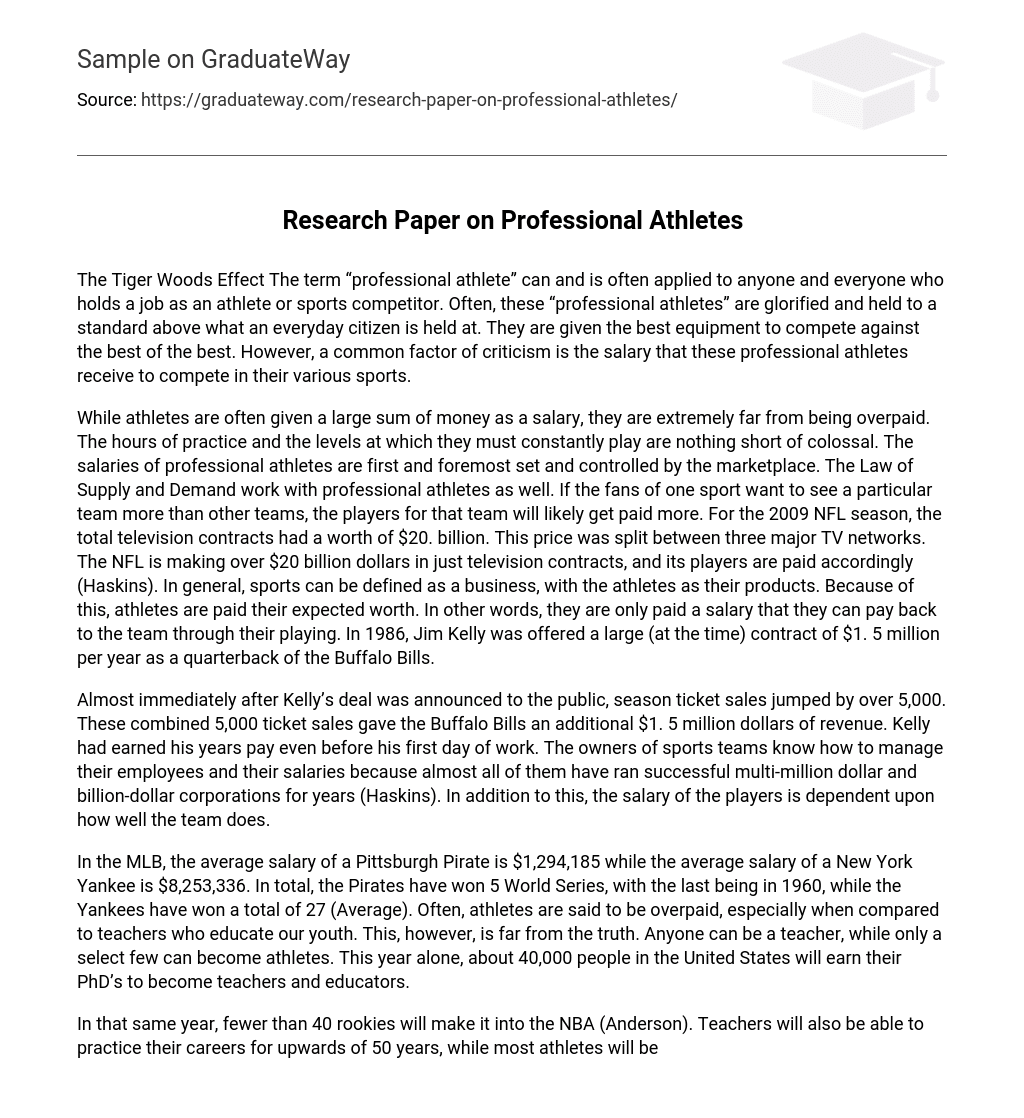The Tiger Woods Effect The term “professional athlete” can and is often applied to anyone and everyone who holds a job as an athlete or sports competitor. Often, these “professional athletes” are glorified and held to a standard above what an everyday citizen is held at. They are given the best equipment to compete against the best of the best. However, a common factor of criticism is the salary that these professional athletes receive to compete in their various sports.
While athletes are often given a large sum of money as a salary, they are extremely far from being overpaid. The hours of practice and the levels at which they must constantly play are nothing short of colossal. The salaries of professional athletes are first and foremost set and controlled by the marketplace. The Law of Supply and Demand work with professional athletes as well. If the fans of one sport want to see a particular team more than other teams, the players for that team will likely get paid more. For the 2009 NFL season, the total television contracts had a worth of $20. billion. This price was split between three major TV networks. The NFL is making over $20 billion dollars in just television contracts, and its players are paid accordingly (Haskins). In general, sports can be defined as a business, with the athletes as their products. Because of this, athletes are paid their expected worth. In other words, they are only paid a salary that they can pay back to the team through their playing. In 1986, Jim Kelly was offered a large (at the time) contract of $1. 5 million per year as a quarterback of the Buffalo Bills.
Almost immediately after Kelly’s deal was announced to the public, season ticket sales jumped by over 5,000. These combined 5,000 ticket sales gave the Buffalo Bills an additional $1. 5 million dollars of revenue. Kelly had earned his years pay even before his first day of work. The owners of sports teams know how to manage their employees and their salaries because almost all of them have ran successful multi-million dollar and billion-dollar corporations for years (Haskins). In addition to this, the salary of the players is dependent upon how well the team does.
In the MLB, the average salary of a Pittsburgh Pirate is $1,294,185 while the average salary of a New York Yankee is $8,253,336. In total, the Pirates have won 5 World Series, with the last being in 1960, while the Yankees have won a total of 27 (Average). Often, athletes are said to be overpaid, especially when compared to teachers who educate our youth. This, however, is far from the truth. Anyone can be a teacher, while only a select few can become athletes. This year alone, about 40,000 people in the United States will earn their PhD’s to become teachers and educators.
In that same year, fewer than 40 rookies will make it into the NBA (Anderson). Teachers will also be able to practice their careers for upwards of 50 years, while most athletes will be employed for just a few seasons, at most. In addition to this, people spend far more money on education than sports. In 1995, $524 Billion was spent on education in the United States, while only $13 Billion was spent on sports (Anderson). In general, athletes are only paid because the people continue to “pay” them by watching them perform (Johnson).
For example, Tiger Woods is set to become the first ever Billion dollar athlete. While Tiger has won 14 Major Championships and 50 PGA Tournaments, only about 10% of his earnings came from prize money. The other 90% of his riches can be attributed to sponsorships. Because sponsorships are only worth the marketing potential of the sponsee, people essentially pay the athlete the money (Forbes). Professional athletes are also wrongly compared to other careers. Professional athletes have very demanding jobs, both physically and mentally.
They also must be in the best shape possible at all times. Almost every professional athlete works out year-round during both their regular season as well as their off season. During the regular season, most professional athletes will practice well over 40 hours a week. They will also have to attend team meetings and press conferences, among other things. Those athletes on teams also have to abide by curfews and may have restrictions as to what they can and cannot do. These professional athletes must also perform at the highest level at all times.
If their level of play begins to lower, they could lose their jobs at any time. They have extremely low job security (Professional). As of May 2008, about 16,500 people in the United States held jobs as professional athletes. While the salaries vary with the sport, the average yearly wage of a professional athlete was $79,460. When growing up, most professional athletes played youth, high school, and college sports. Because most colleges require high grades from their athletes, they also have to balance their studies and practices.
Most professional athletes also spend much of their lives practicing (Professional). In conclusion, professional athletes are far from being overpaid. Their pay is set by the marketplace and the Law of Supply and Demand. When compared to other professionals, athletes have worked far more. Almost all of them have spent a lifetime practicing and have out-competed the many other people trying to get a spot on a professional sports team. Maybe instead of complaining about how much Kobe makes, you should have been practicing that jump shot too.





